You can transform your yard into a natural pest-repelling fortress by planting lavender, which creates an 80.9% mosquito repellency effect, and marigolds that deter nematodes while thriving in zones 2-11. Catnip’s nepetalactone proves more effective than DEET against mosquitoes, while basil repels aphids and tomato hornworms. Add chrysanthemums containing pyrethrum for eliminating ants, cockroaches, and fleas on contact. These strategic plantings create beautiful landscapes that naturally protect your outdoor spaces from multiple pest invaders while discovering additional powerful plant combinations.
Lavender: The Purple Powerhouse Against Flying Pests
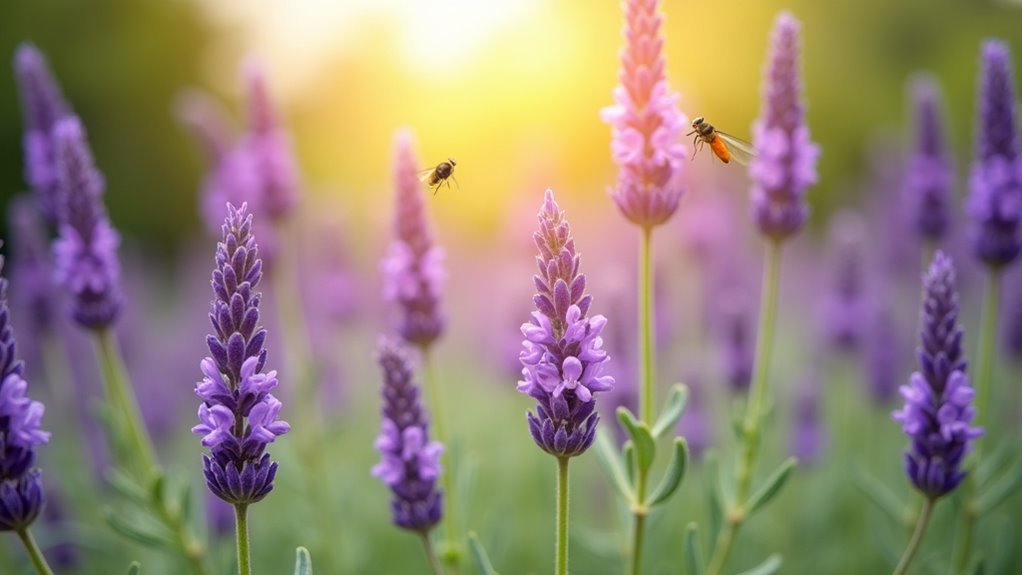
While many gardeners struggle with mosquitoes and flies disrupting their outdoor enjoyment, lavender offers a beautiful and effective solution that’s been proven in scientific studies. This purple powerhouse’s strong aroma creates an 80.9% repellency effect against mosquitoes, matching traditional chemical repellents.
You’ll find lavender thrives in USDA zones 5-9 with full sun exposure and well-draining, sandy soil.
What makes lavender exceptional is its dual purpose – while it deters flying pests, it simultaneously works to attract beneficial insects like bees and butterflies to your garden.
You can extend its pest deterrent properties indoors by creating dried lavender bouquets throughout your home, providing natural protection while filling rooms with pleasant fragrance.
Marigolds: Vibrant Blooms That Deter Garden Invaders
You’ll find marigolds offer exceptional natural nematode protection while adding brilliant orange and yellow colors to your garden borders.
These hardy annuals make perfect companion plants for your vegetables, creating a protective barrier that deters harmful pests without requiring special care.
They’ll thrive in full sun with minimal maintenance, making them an ideal choice if you want effective pest control without complicated gardening routines.
Natural Nematode Protection
When you’re searching for a natural solution to protect your garden from nematodes, marigolds offer both beauty and powerful pest-fighting abilities.
These vibrant flowers emit strong scents that repel pests naturally, making them invaluable for controlling garden pests without chemicals. You’ll find marigolds particularly effective because their flowers produce compounds that inhibit harmful nematode growth in soil, protecting your surrounding plants.
As an ideal companion plant, marigolds create protective barriers in your vegetable gardens while attracting beneficial pollinators like bees and butterflies.
They’re incredibly versatile, thriving in various soil types across USDA Zones 2-11. For best nematode protection, plant your marigolds in full sun locations where they’ll develop their strongest pest-repelling properties while maintaining their stunning visual appeal.
Colorful Companion Planting Benefits
Beyond their nematode-fighting capabilities, marigolds transform your garden into a colorful fortress against multiple pest invaders. These vibrant pest-repelling plants naturally deter mosquitoes, aphids, and various garden threats through their strong scent.
You’ll appreciate how marigolds thrive in USDA zones 2-11, adapting to diverse climates while requiring minimal maintenance.
Colorful companion planting with marigolds creates dual benefits in your vegetable gardens. They’ll reduce tomato hornworm and cabbageworm infestations while attracting beneficial insects like pollinators and predatory species.
This strategic placement establishes a healthy garden ecosystem that protects your crops naturally.
You can easily integrate these annual flowers alongside vegetables and ornamental plants, enhancing aesthetic appeal while maximizing pest-repelling capabilities.
Their full-sun preference and well-draining soil requirements make marigolds perfect companions for most garden layouts.
Easy Care Requirements
Since marigolds thrive with minimal intervention, you can enjoy their pest-repelling benefits without dedicating extensive time to garden maintenance. These hardy plants require only basic care while effectively deterring insects from your garden. You’ll find that marigolds adapt to various conditions and continue blooming throughout summer with little attention.
| Care Requirement | Marigolds Need |
|---|---|
| Sunlight | Full sun exposure |
| Soil Type | Well-draining soil |
| Watering | Moderate moisture |
| Maintenance | Minimal intervention |
Their resilience makes them perfect for busy gardeners who want natural pest control. Marigolds repel mosquitoes, aphids, and nematodes while requiring no special fertilizers or frequent watering. You can plant these low-maintenance flowers and trust they’ll protect surrounding plants from harmful pests without constant care.
Basil: Aromatic Herb Protection for Outdoor Spaces
While many homeowners struggle with mosquitoes and garden pests, basil offers a fragrant solution that serves multiple purposes in your outdoor space. This aromatic herb naturally repels pests including mosquitoes, aphids, and tomato hornworms without harsh chemicals.
You’ll find basil thrives in full sun with well-drained, fertile soil, making it perfect for garden beds or patio containers.
Growing 8-12 inches tall, basil flourishes as an annual in USDA zones 4-11. Beyond pest control, this versatile herb attracts beneficial insects like bees and butterflies, supporting your garden’s ecosystem.
You can harvest the fragrant leaves for culinary uses while maintaining natural protection. Pairing basil with companion plants like tomatoes and peppers enhances pest deterrent effects and promotes healthier overall plant growth.
Catnip: Natural Mosquito Repellent Stronger Than DEET
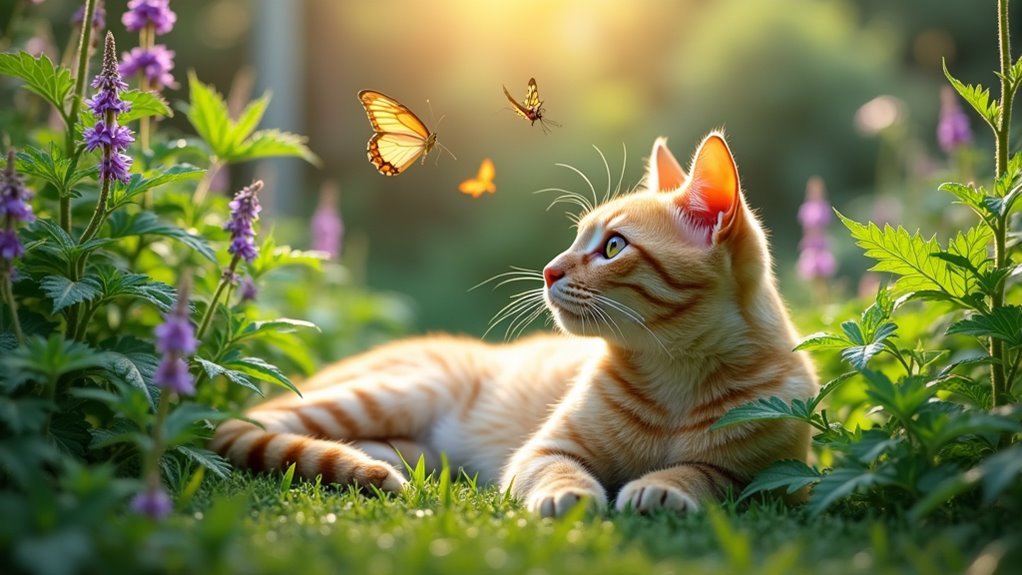
You’ll be amazed to learn that catnip contains nepetalactone, a compound that’s proven more effective at repelling mosquitoes than DEET in laboratory studies.
While synthetic repellents dominate the market, this common garden herb offers superior natural protection against these blood-sucking pests.
Growing catnip successfully requires understanding its preferences for full sun and well-draining soil, making it an accessible addition to most yards.
Catnip’s Mosquito-Fighting Power
Although most people associate catnip with feline entertainment, this remarkable herb packs a mosquito-repelling punch that’ll surprise you.
Laboratory studies prove that catnip’s active compound, nepetalactone, outperforms DEET in repelling mosquitoes. This powerhouse herb doesn’t stop there—its potent scents also deter cockroaches and termites, making it a triple-threat for pest control.
You’ll love how this functional plant enhances your garden’s beauty while protecting your space. Catnip grows 3 to 4 feet tall and produces charming small lavender flowers that add visual appeal to any landscape.
The same strong fragrance that attracts cats creates an invisible barrier against various insects. By incorporating catnip into your yard, you’re choosing an effective, natural alternative to chemical repellents that works harder than traditional options.
DEET Vs Natural Catnip
When you compare DEET to catnip’s natural mosquito-fighting abilities, the results will astound you. This remarkable natural insect repellent delivers up to 10 times more protection against mosquitoes than DEET, making it an incredibly effective pest repelling solution.
Unlike synthetic DEET, which often causes skin irritation and unwanted side effects, catnip offers completely non-toxic protection for your family and pets.
The aromatic properties of catnip become most potent when you crush its leaves, releasing nepetalactone compounds that mosquitoes absolutely can’t tolerate.
You’ll appreciate that this powerful plant provides superior defense without harsh chemicals. Growing catnip in your yard means you’re choosing a safer, more effective approach to mosquito control that outperforms traditional synthetic repellents while maintaining complete safety for everyone.
Growing Catnip Successfully
Since catnip thrives in USDA zones 3 through 9, you can successfully cultivate this powerful mosquito repellent in most climates across North America.
This hardy perennial requires specific conditions for ideal nepetalactone production and effective pest control.
Essential growing requirements:
- Location: Plant in full sun areas with fertile, well-draining soil
- Space: Allow room for 3-4 foot height and natural spreading
- Maintenance: Control growth regularly to prevent overtaking other plants
- Benefits: Enjoy lavender flowers that attract beneficial insects while repelling mosquitoes
- Timing: Establish in spring for full-season protection
Growing catnip successfully means balancing its vigorous spreading nature with strategic placement.
You’ll get maximum mosquito-repelling benefits when it receives adequate sunlight, encouraging strong nepetalactone concentration throughout the growing season.
Rosemary: Evergreen Defense Against Multiple Pest Species
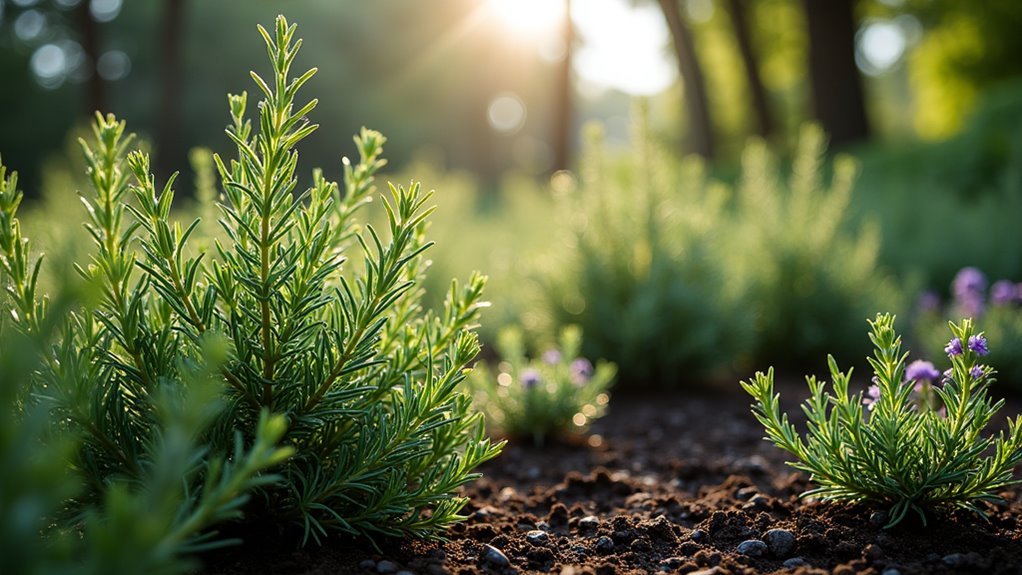
Rosemary stands as one of nature’s most effective multi-purpose pest deterrents, combining culinary value with powerful insect-repelling properties. This woody evergreen shrub uses its strong aromatic essential oils to repel pests including Japanese beetles, cabbage moths, and slugs.
You’ll find rosemary thrives in USDA Zones 7-10, requiring full sun and well-draining soil for prime growth.
Growing 1-6 feet tall and 2-4 feet wide, rosemary serves dual purposes as both a culinary herb and landscape plant. When you plant rosemary strategically throughout your garden, you’re creating a natural pest barrier that enhances your yard’s biodiversity.
The same essential oils that deter insects can be harvested for cooking, making this versatile plant an excellent investment for any pest-conscious gardener.
Mint: Fast-Spreading Ground Cover That Repels Rodents
While rosemary offers excellent pest control in warmer climates, mint provides an equally powerful solution that thrives across a much broader range of growing zones.
This fast-growing perennial spreads aggressively through underground stolons, creating effective ground cover that repels rodents naturally.
Mint’s strong scent, derived from concentrated essential oils, deters pests and insects including mice and fleas.
Here’s why you’ll love adding mint to your yard:
- Thrives in USDA Zones 3-11 with minimal care
- Creates dense ground cover that blocks pest pathways
- Strong aromatic oils naturally repel multiple pest species
- Doubles as ingredients for culinary dishes and beverages
- Requires only full sun and well-draining soil
Consider containing mint in pots to prevent it from overwhelming other plants in your garden.
Nasturtiums: Colorful Trap Crops for Aphids and Beetles
Beyond ground cover solutions like mint, nasturtiums offer a completely different approach to pest management through their role as colorful trap crops. These vibrant colorful annual plants attract beneficial insects while simultaneously drawing harmful pests like aphids, squash bugs, and cucumber beetles away from your valuable crops.
You’ll find nasturtiums exceptionally versatile since they thrive in USDA Zones 2 to 11 and adapt to various light conditions. Plant them along your vegetable gardens’ edges to repel harmful pests through airborne chemicals that protect neighboring plants.
As an effective trap crop, they’ll lure destructive insects away from your prized vegetables. The bonus? This edible plant provides culinary value—you can harvest both leaves and flowers for salads while maintaining natural pest control.
Chrysanthemums: Pyrethrum-Rich Flowers for All-Season Protection
Unlike nasturtiums that serve primarily as trap crops, chrysanthemums deliver direct pest elimination through pyrethrum—a potent natural compound that effectively repels ants, cockroaches, ticks, fleas, and bedbugs.
Chrysanthemums pack a powerful punch with pyrethrum, naturally eliminating household pests like ants, ticks, fleas, and bedbugs on contact.
This natural insect repellent makes them powerful allies in thorough pest control strategies.
You’ll maximize their effectiveness by planting chrysanthemums strategically throughout your landscape:
- Position along garden borders for continuous perimeter protection
- Choose full sun locations with well-draining sandy or loamy soil
- Plant in USDA Zones 5-9 for ideal growth conditions
- Create colorful arrangements that blend function with visual appeal
- Incorporate near outdoor seating areas for enhanced comfort
These vibrant flowers attract beneficial insects while maintaining a pest-free environment, supporting natural biodiversity that strengthens your yard’s ecological balance year-round.
Alliums: Ornamental Onion Family Plants That Repel Slugs
Alliums represent nature’s elegant solution to slug problems, combining striking ornamental beauty with powerful pest-deterrent properties. These versatile plants from the onion family don’t just repel slugs – they’re your garden’s multitasking defenders against aphids, cabbage worms, and carrot flies.
| Plant Varieties | Pest Control Benefits |
|---|---|
| Leeks & Chives | Repel slugs and aphids |
| Garlic | Deter carrot flies |
| Ornamental Alliums | Multi-pest protection |
You’ll find alliums work exceptionally well as a companion plant alongside roses, protecting them from destructive aphids. Their ornamental flowers add stunning visual appeal while providing natural pest control, eliminating your need for chemical insecticides. These perennials thrive in USDA Zones 3-9, requiring full sun and well-draining soil for peak performance.
Lemongrass: Citronella-Scented Grass for Mosquito Control
When mosquitoes threaten to turn your peaceful evenings outdoors into battles against buzzing pests, lemongrass emerges as your aromatic guardian. This citronella-scented grass delivers powerful mosquito repellent properties while adding beauty to your landscape.
Lemongrass contains natural citronella oil, the same compound found in commercial pest control products. You’ll appreciate its dual-purpose nature as both an effective deterrent and stunning ornamental plant.
- Grows 3-6 feet tall with striking grass-like foliage
- Thrives in full sun and well-draining, moist soil
- Hardy in USDA Zones 9-11 for year-round protection
- Container-friendly for versatile placement options
- Offers culinary applications for Asian-inspired cooking
This perennial grass transforms your yard into a mosquito-free zone while providing fresh ingredients for your kitchen, making it an invaluable addition to any garden.
Frequently Asked Questions
What Plant Repels the Most Insects?
Catnip repels the most insects since it’s proven more effective than DEET against mosquitoes. You’ll find its nepetalactone compound provides superior protection compared to other plants like lemongrass or lavender in laboratory testing.
What Plant Works as a Natural Pest Control?
You’ll find marigolds work exceptionally well as natural pest control since they produce pyrethrum, a powerful insect repellent that deters nematodes and various garden pests while enhancing your garden’s overall health.
What Plants Keep Bugs and Rodents Away?
You’ll want basil and lavender to repel mosquitoes and flies, while marigolds deter nematodes. Catnip’s nepetalactone outperforms DEET against mosquitoes and cockroaches. Rosemary’s strong scent keeps cabbage moths and slugs away effectively.
What Smell Do All Bugs Hate the Most?
You’ll find citronella’s the most universally hated scent among bugs. It’s derived from lemongrass and disrupts insects’ olfactory senses effectively. Most mosquitoes, flies, and other pests can’t tolerate this powerful natural compound.
In Summary
You’ll transform your yard into a natural fortress against pests by planting these powerful defenders. You’re not just creating a beautiful garden—you’re building an eco-friendly barrier that works around the clock. These plants won’t just repel unwanted insects; they’ll attract beneficial pollinators and add stunning colors and fragrances to your outdoor space. You’ve got everything you need to reclaim your yard naturally and effectively.

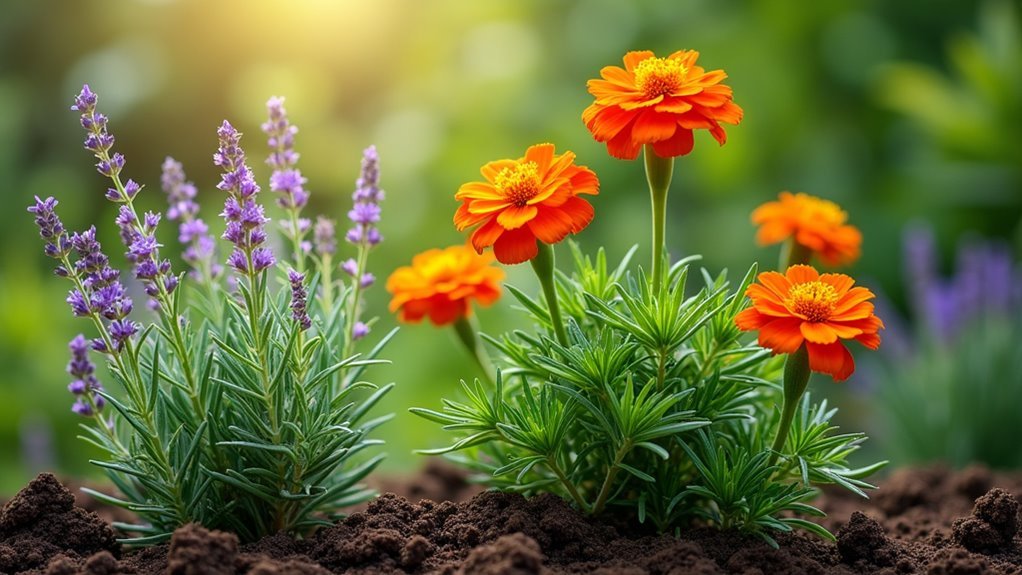


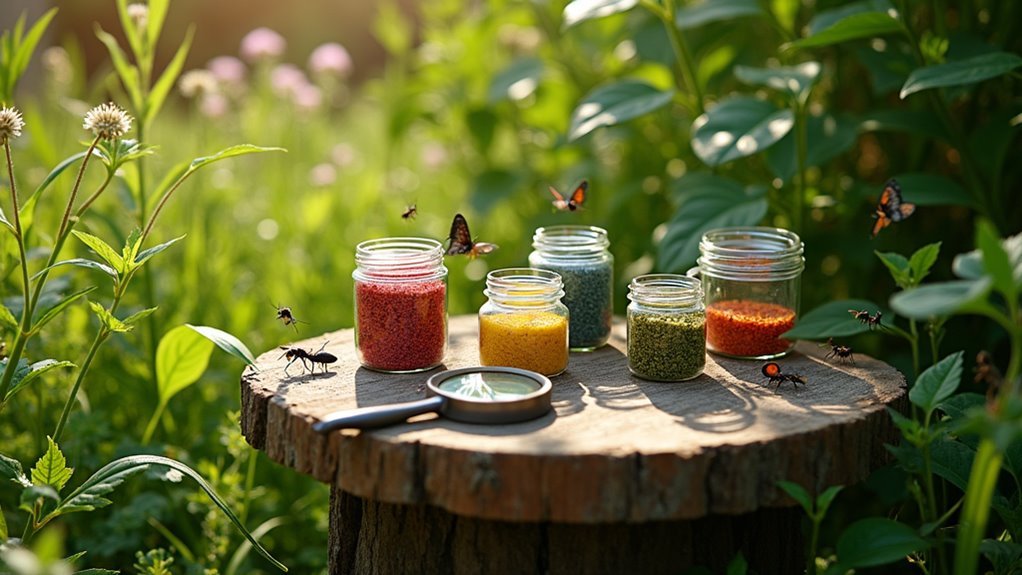
Leave a Reply